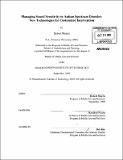| dc.contributor.advisor | Rosalind Picard. | en_US |
| dc.contributor.author | Morris, Robert | en_US |
| dc.contributor.other | Massachusetts Institute of Technology. Dept. of Architecture. Program in Media Arts and Sciences. | en_US |
| dc.date.accessioned | 2010-05-25T21:02:53Z | |
| dc.date.available | 2010-05-25T21:02:53Z | |
| dc.date.copyright | 2009 | en_US |
| dc.date.issued | 2009 | en_US |
| dc.identifier.uri | http://hdl.handle.net/1721.1/55196 | |
| dc.description | Thesis (S.M.)--Massachusetts Institute of Technology, School of Architecture and Planning, Program in Media Arts and Sciences, 2009. | en_US |
| dc.description | Cataloged from PDF version of thesis. | en_US |
| dc.description | Includes bibliographical references (p. 80-84). | en_US |
| dc.description.abstract | Many individuals diagnosed with autism experience auditory sensitivity - a condition that can cause irritation, pain, and, in some cases, profound fear. Efforts have been made to manage sound sensitivities in autism, but there is wide room for improvement. This thesis describes a new intervention that leverages the power of "Scratch" - an open source software are platform that can be used to build customizable games and visualizations. The intervention borrows principles from exposure therapy and uses Scratch to help individuals gradually habituate to sounds they might ordinarily find irritating, painful, or frightening. Facets of the proposed intervention were evaluated in a laboratory experiment conducted on a non-clinical population. The intervention was also tested on three autistic individuals with histories of auditory hypersensitivity. One case study participant showed signs of complete remission of his auditory sensitivity issue, while another showed signs of gradual improvement. Future research designs are discussed that could evaluate these findings in greater detail. | en_US |
| dc.description.statementofresponsibility | by Robert Morris. | en_US |
| dc.format.extent | 86 p. | en_US |
| dc.language.iso | eng | en_US |
| dc.publisher | Massachusetts Institute of Technology | en_US |
| dc.rights | M.I.T. theses are protected by
copyright. They may be viewed from this source for any purpose, but
reproduction or distribution in any format is prohibited without written
permission. See provided URL for inquiries about permission. | en_US |
| dc.rights.uri | http://dspace.mit.edu/handle/1721.1/7582 | en_US |
| dc.subject | Architecture. Program in Media Arts and Sciences. | en_US |
| dc.title | Managing sound sensitivity in autism spectrum disorder : new technologies for customized intervention | en_US |
| dc.type | Thesis | en_US |
| dc.description.degree | S.M. | en_US |
| dc.contributor.department | Program in Media Arts and Sciences (Massachusetts Institute of Technology) | |
| dc.identifier.oclc | 609407201 | en_US |
